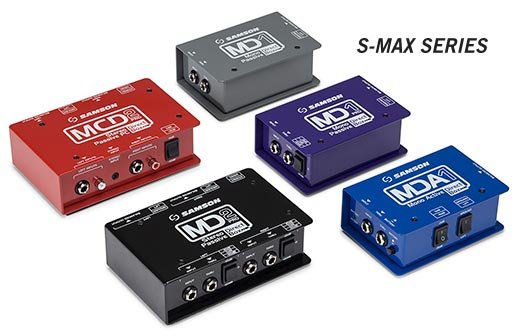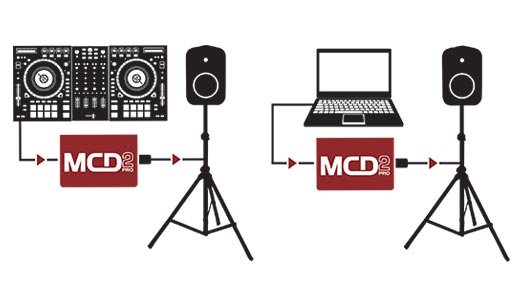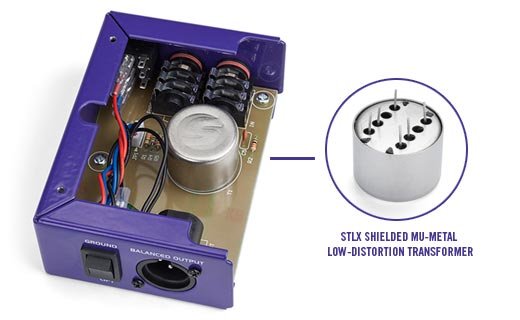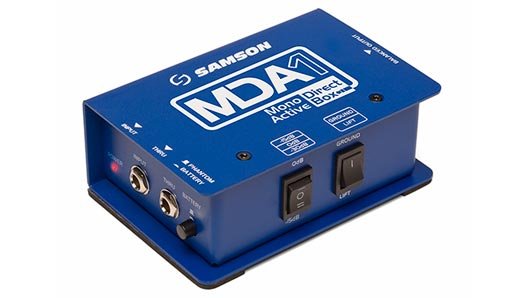Straight Talk About Direct Boxes — Part 1

In the audio world, there are few purchases less glamorous—yet more essential—than the unimposing direct box. It’s not the type of product one longs for, or dreams of, one day owning; but it may be the one piece of equipment that can rescue your next live gig or studio session. And for many aspiring musicians, the need for a direct box comes to light the first time you hand the sound engineer the 1/4″ output cable from your guitar, bass, or keyboard—and she shakes her head and hands you a balanced XLR cable. Something else needs to happen.
Direct Box to the Rescue!
Using a Samson S-Max Series Direct Box assures that you can take the output of your electric guitar, electric bass, preamp, pedalboard, drum machine, groovebox, keyboard, MP3 player, computer or other audio source, and quickly convert it so that it can be easily routed directly to a live mixing board or recording console—usually via an audio snake or studio wall panel.
Basics of the Box
Also known as a D.I. (Direct Injection) box, your direct box is essentially a transformer. The output of your instrument is connected to the input of the direct box. The output of the direct box is connected to the recording console or the house sound system. Inside, the direct box converts the unbalanced high-impedance [Hi-Z] input into a balanced low-impedance [Lo-Z] output. Performing this conversion is the sole function of a direct box. Direct boxes come in a variety of shapes and sizes—mono or stereo, active or passive, and even special multi-media models designed for laptop musicians, EDM artists, and other content creators.

Why Use a Direct Box?
Making the connection to the mixer or console is a must if you want the sound of your instrument to be recorded, played through the house sound system, or to appear in the stage monitors. With the advent of in-ear monitors, off-the-board recording, and the clean look of an amplifier-free stage, the ability to connect to the main mixer has grown even more important—and the direct box is the key. Often, the only way to connect your instrument to a mixer or console is to use the microphone inputs. And frequently, the only way to do so from the performance area is to plug into an audio snake. These audio snakes are equipped with multiple Lo-Z balanced XLR inputs designed to carry many individual audio channels over the long distance to the main mixing board. In the recording studio, similar snakes or wall boxes bring the audio signals from the live room through the walls into the control room, and then to the main console.
When Not to Use a Direct Box
In the home or project studio, where cable lengths are short, modern stand-alone computer audio interfaces and USB-equipped mixers are often equipped with Hi-Z unbalanced inputs that are compatible with your instrument output, so a direct box may not be necessary. When mic’ing up a guitar amp to capture the sound of the speakers, the microphone is already providing a balanced low impedance signal, so again there is no need for a direct box.

Making it All Work
Outside, direct boxes must stand up to the rigors of life on the road; and Samson S-Max Direct Boxes utilize a robust 14 gauge steel chassis. Inside, there are a number of features that improve the performance, fidelity, and functionality of each direct box.
THRU Jack
One of the most valuable additions to the direct box is the Thru jack. This secondary 1/4″ unbalanced output allows the direct box to sit discreetly in the original signal chain. The balanced output feeds the sound system, and the Thru jack sends the input signal along its original path.
GROUND LIFT Switch
The cable connecting two electronic components (such as on-stage guitar amp and the mixing board) can connect the grounding path of the two components, creating a ground loop and introducing unwanted hum. The ground lift switch isolates the ground paths and eliminates ground loop hum.
ATTENUATION Switch
Because the input can come from a variety of sources—instrument; preamp loop; line output; etc.—many direct boxes are equipped with a switch to attenuate the input level to avoid overloading the input and causing unwanted distortion.
Certain direct boxes such as the Samson S-Max MD1 Pro can even accept a speaker level signal as the input, using the Attenuation switch to provide an impedance match based on the Watt/Ohm rating of the amplifier output.
Stereo Operation
Stereo direct boxes are ideal for providing matching left and right signals from a stereo source such as a keyboard, drum machine, etc. A good stereo direct box may include a stereo/mono sum switch.
Special use stereo direct boxes, including the Samson S-Max MCD2 Pro, provide RCA, 1/8″ stereo, and 1/4″ inputs to accommodate instruments, mixers, laptops, and MP3 players—as well as DJ and EDM gear.
Premium Components
As with guitar pickups, loudspeakers, and microphone coils, the quality and materials used in the transformer coil have a profound impact on the fidelity. Samson S-Max direct boxes use either STL or STLX shielded mu-metal low-distortion transformers with an extended flat audio response.

Active Electronics
Most direct boxes are passive, requiring no external power source. Active direct boxes are powered via an internal battery, phantom power from the console, or from an external power supply. Technically, an active direct box functions as a preamp; they also provide a fixed input impedance level that is not affected by the load impedance. Applying active circuitry preserves the upper-end frequencies and harmonics, making it the perfect solution when connecting an electric guitar directly into the direct box input. The tradeoff when using an active direct box is diminished ground isolation.

